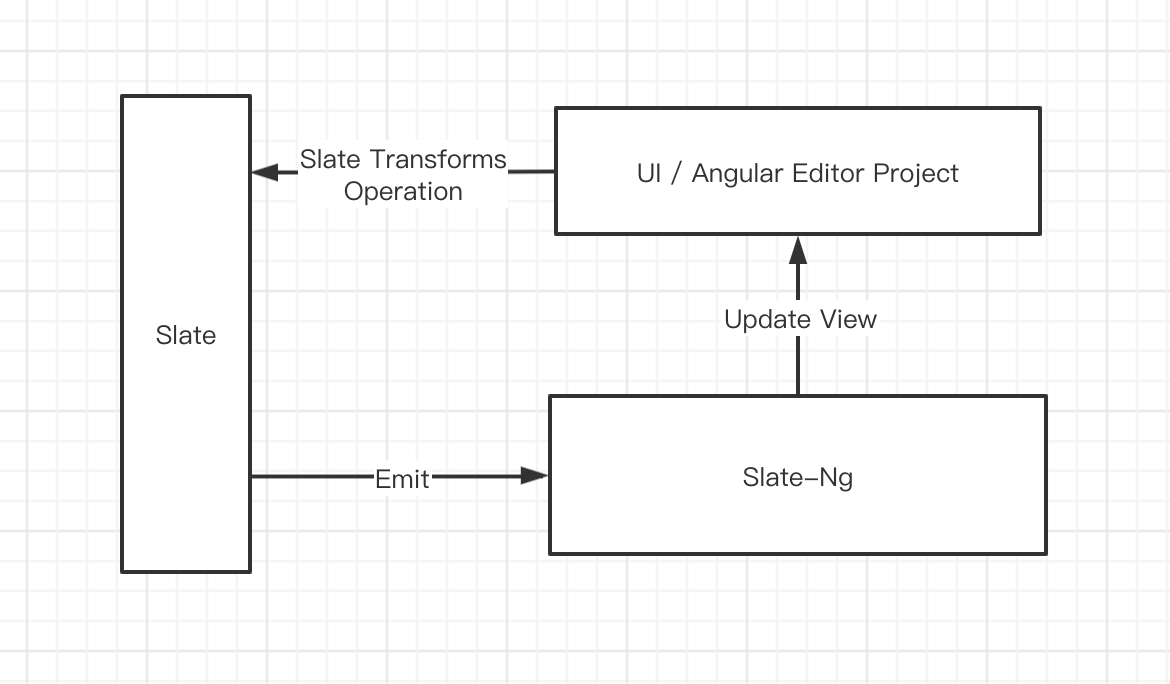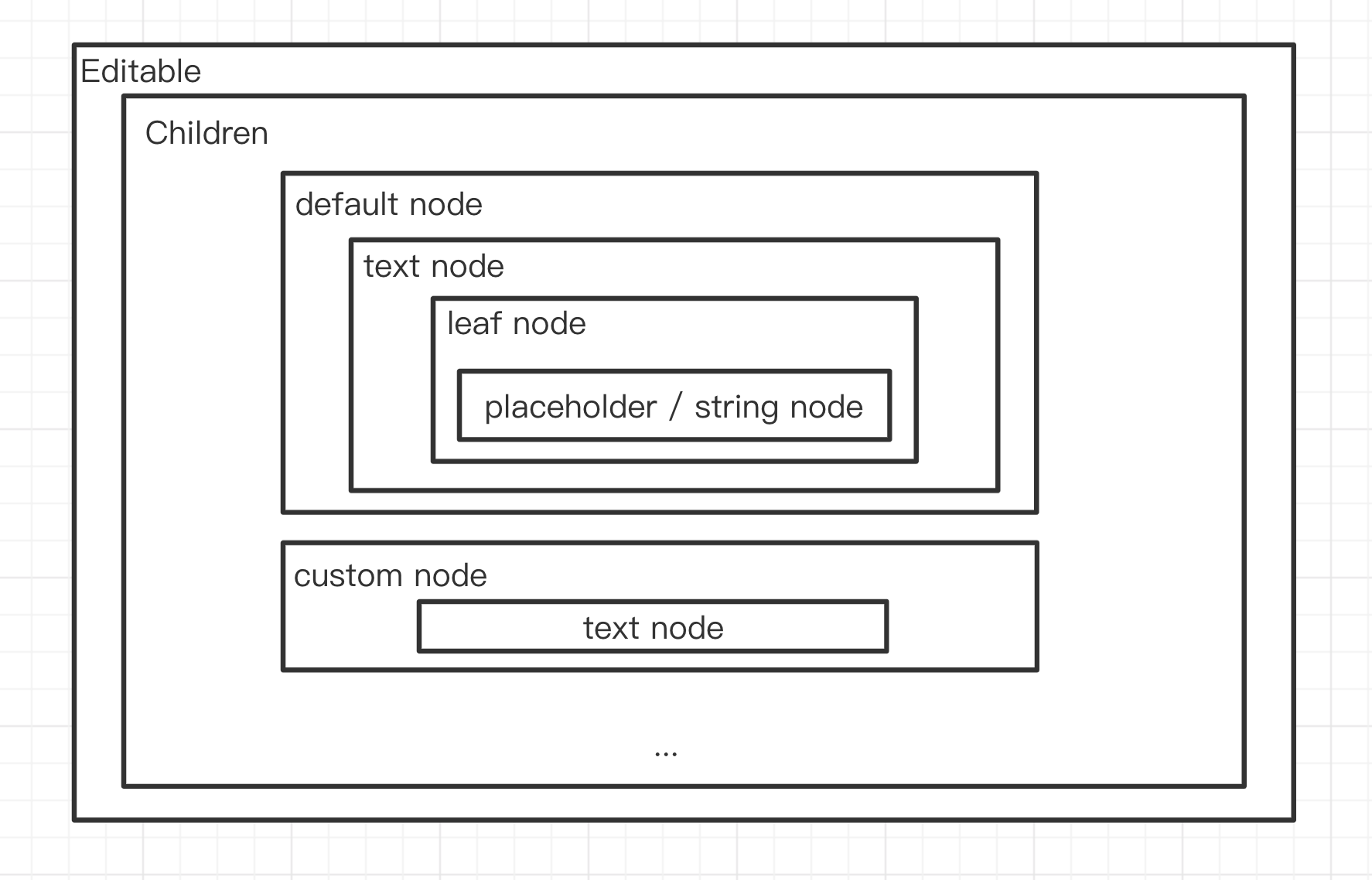实现方案介绍 (修改中)
交互逻辑

方案介绍
slate-ng大致结构:

从图中,我们可以看到slate-ng大概的结构,在slate-ng中将每个Slate Node当做一个组件, 根据一定的要求进行组装成 Component Portal, 并挂载到对应位置进行渲染显示,而在这里面核心点就在children下的逻辑,这里涉及几个点:
- 如何获取每个node对应的组件?
- 如何处理每个node对应的组件和其子项 ?
- 如何传递上下文到每个动态组件中 ?
- 如何优化处理方案 ?
那么我们一点一点过一下:
1. 如何获取每个node对应的组件 ?
这里将区别于react处理方式,在react中通过renderElement,renderLeaf,renderPlaceholder分别传递到组件内进行处理,但是在slate-ng中我们无法较好的享有这种方式带来的好处, 故我简化为如下传递和存储(在slate-ng实现上会有一些区别如下,可查看registry-ns-element):
```
// 初始存储的内容
const defaultStore = {
default: DefalutElementComponent,
text: TextComponent,
leaf: LeafComponent,
placeholder: PlaceholderComponent
}
// 新建一个Node对应的Component
@Component({...})
export class ComponentA {
static type = 'A' // 组件的标识
}
// 使用service进行注册
this.registryService.add([ComponentA, ComponentB])
// 最终得到的store
const store = {
...defaultStore,
A: ComponentA
}
// 获取时直接从对象根据type获取
```
2. 如何处理每个node对应的组件和其子项 ?
在这里我参考了react use-children的一些处理方式,创建了children组件,该组件用于递归遍历editor的数据组装出一个完整的portals,代码如下(简化后的代码):
```
resolvePortals(pNode: Ancestor): Array<ComponentPortal<any>> {
const children = [];
const editor = this.editorService.editor;
// ...
for (let i = 0; i < pNode.children.length; i++) {
const cNode = pNode.children[i] as Ancestor | Descendant;
// ...
let childPortals = [];
let portal = null;
if ((cNode as Ancestor).children) {
childPortals = this.resolvePortals(cNode as Ancestor); // 重点
}
// 通过Injector存储childProtals
const providers = [
{provide: CHILD_PORTALS_TOKEN, useValue: childPortals }
// ...
];
// ...
portal = new ComponentPortal(this.regsitorService.get(type), injector.create(providers, this.injector));
children.push(portal);
}
return children;
}
// portals
[
ComponentPortalA,
ComponentPortalB,
...
]
```
可能会觉得奇怪,那child的内容在哪,这里涉及到componentportal injector知识,前面注解也有提到,也就是说,每个ComponentPortal事实上带着一个它的childPortals,你可以将产出的protals理解为这样的结构(真实结构肯定不这样,但是你可以大致这么理解我们有这么一个大概的结构):
```
[
ComponentPortalA: {
injector: {
child_token: [
ComponentPortalA0,
ComponentPortalA1
]
}
},
ComponentPortalB // 同样
]
```
最终我们丢到html中进行处理渲染:
```
<ng-container *ngFor="let portal of showPortals;">
<ng-template [cdkPortalOutlet]="portal"></ng-template>
</ng-container>
```
3. 如何传递上下文到每个动态组件中 ?
事实上我们在第二点中也有涉及,那就是Component允许传递injector,我们将所需要的内容通过Injector.create(providers, this.parentInjector)传递
4. 如何优化处理方案 ?
在这里有个问题,因为我们每次都会创建一个新的ComponentPortal,但是得注意,假设我们有一个序列,结构如下:
```
{
type: 'list',
children: [
{
type: 'li',
...
}
]
}
```
如果进行一次序列增加操作,它将会在children中增加一个li,而在前面的处理中每次都会重新创建一个新的ComponentPortal,这意味着一个小变更我们都需要完全的重新渲染,这是一个性能消耗非常大的问题,故我们需要做缓存,我们只需要让变更的node重新创建新的portal,其他继续使用之前的,代码地址